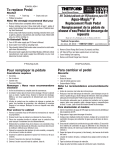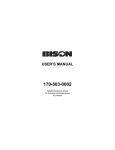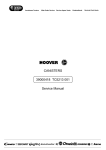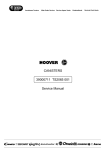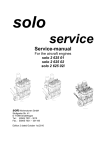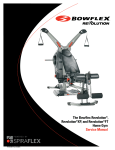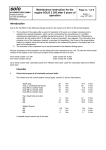Download Service Manual
Transcript
Service Manual 425 / 435 / 475 /485 456 / 457 9 425 300 1 CONTENTS OPERATING DISCRIPTION Specifications Page Technical Data Operating Description 425/435/475/485 Operating Description 456/457 Backpack Sprayer Trouble Shooting Guide Piston Pump Diaphragm Pump Pressure cylinder Handheld Sprayer Trouble Shooting Guide Handheld Sprayer Shut-off valve 2 2 2 3 4 6 8 9 10 12 OPERATING DESCRIPTION Compression Sprayer 456, 457 During the upward stroke, the o-ring on the plunger moves to the fluted side of the o-ring groove and allows air to be drawn past the o-ring and into the pump cylinder. On the downward stroke, the o-ring presses against the solid side of the o-ring groove and blocks air from escaping past the o-ring. As the downward stroke continues, air is compressed in the pump cylinder and is expelled past the check valve on the bottom of the cylinder and into the tank. As more air is pumped into the tank, the pressure is increased. Pressure in excess of 45 PSI is released through the spring loaded pressure relief valve. When the shut off valve is opened, liquid is forced through a pick-up tube in the spray tank. From the pick-up tube, the liquid travels through the hose, shut-off valve and finally out the nozzle. Backpack Sprayers 425, 435, 475, 485 During the upward stroke of the handle on either the piston or diaphragm, liquid is drawn from the formula tank through the intake channel into the space above the pump. The lower valve plate opens intake channel while the upper valve plate closes the transfer ports. During subsequent upward stroke of piston or diaphragm, the previously siphoned liquid is forced through the four transfer ports and into the pressure cylinder. During this compression phase, the upper valve plate opens the transfer ports and the lower valve plate closes, sealing the intake channel. The transfer ports cannot be sealed by the lower valve plate. Through repetition of these piston or diaphragm strokes, the air present in the pressure cylinder is beeing slowly compressed by the forced-in liquid. A prerequisite for this condition is a closed shut-off valve. These pumping strokes can be carried out so long until the required pressure is reached. After opening the shut-off valve, continue to pump slowly and steadily in order to achieve a consistent rate of discharge. TECHNICAL DATA 425 475 456 457 Weight, Empty Tank capacity Pump system Pressure Chamber Displacement (Pump Cylinder) Operating pressure Total Height Total Width Depth 9.5 Lbs 4,3 Kg 4 US Gal 15 L Piston 1.4 US Q/ 1,3 L 9.5Lbs 4,3 Kg 4 US Gal 15 L Diaphragm 1.4 US Q/ 1,3 L 5.5 Lbs 2,5 Kg 1. 5 US Gal 5,0 L Piston N/A 6.5 Lbs 3,5 Kg 2 US Gal 7,5 L Piston N/A 4.9 CU IN 90 PSI 6 ATM 21 IN 13.75 IN 8.25 IN 4.9 CU IN 60 PSI 4 ATM 21 IN 13.75 IN 8.25 IN 21.1 CU IN 45 PSI 3 ATM 17.25 IN 8.25 IN N/A 21.1 CU IN 45 PSI 3 ATM 23 IN 8.25 IN N/A 2 BACKPACK SPRAYER TROUBLE SHOOTING GUIDE PROBLEM CAUSE SOLUTION Difficulty In moving Pump lever Dirty bushing Collar swollen (425) from long term exposure Remove pump lever, clean & grease bushings Remove piston, clean/ replace piston & collar Replace collar and maintain according to instructions Lack of lubrication (425). Lubricate viton collar Damaged/ dirty valve plates Damaged o-ring at valve seat Clean or replace valve plates or cylinder Replace o-ring Collar or piston (425) worn Replace collar or piston Sealing in pressure regulator is leaking Check seal and valve seat High resistance after just a few pumping strokes, pressure lasts only briefly Little or no air cushion in pressure cylinder Remove PVC hose, drain pressure cylinder, reconnect hose, preventive measure: release pressure after each use During Spraying, upward pumping becomes more & more difficult and tank walls may indent inwards. Wrong formula tank cap (No vent hole) Replace with vented cap Vent hole clogged Clean vent hole Lower valve plate sticks Replace valve plate Intake channels clogged Clean channels & tank When handle is pulled up it wants to move itself forcibly back down. Screen at base of pressure cylinder clogged Clean intake screen with a small brush and detergent Leaks inside cylinder (425) Damaged/ dirty collar or piston Leaks outside cylinder (425) Damaged o-ring on cylinder Clean or replace collar and possibly cylinder if worn Replace o-ring Dirty cylinder walls (425). Insufficient resistance during repeated pumping and no pressure Leaks on diaphragm pump (475) Leaks from end of spray Wand Damaged o-ring on pressure cylinder Replace o-ring Damaged diaphragm Replace diaphragm Damaged o-ring on diaphragm housing Replace o-ring Damaged o-ring on pressure cylinder Worn or damaged shut-off valve Replace o-ring Inspect and rebuild shut-off valve 3 PISTON PUMP 1) Loosen the stop plate (A). Remove the bolt and nut in the protective cap and pull protective cap off (C). Remove the two (2) allen head bolts (D) from the lever. The piston can then be pulled from the cylinder (E). (See figure 1). Also, loosen the clamp (F) and remove the hose. Fig. 1 2) Remove the pump cylinder by turning it counter-clockwise from the bottom of the pressure cylinder. (See figure 2). Fig. 2 3) Check the inside of the pump cylinder and the piston for vertical scratches. If the cylinder is scratched, replace it. Fig. 3 4) To disconnect the piston from the connecting rod, pry the two (2) halves of the connecting rod apart with a flathead screwdriver. (See Figure 4) Fig. 4 5) With a new piston, line up the connecting rod on the posts inside the piston and on the lever. Snap the connecting rods together. (See Figure 5). Fig. 5 4 6) To replace the Viton collar, push it off with the top of the piston with your thumb. The new one is simply pushed over the piston crown into the form fitted sides. (See Figure 6). 7) To replace the valve plates and o-rings on the pump cylinder: remove the outer o-rings, the top valve plate and replace. The lower valve plate (inside the cylinder) is replaced by pulling out the retaining pin. Use pliers. (See Figure 7). Replace the valve plate and then push the holding pin back into place. Fig. 6 Fig. 7 Fig. 8 8) The pump cylinder screws into the pressure cylinder. A little grease on the o-ring makes reassembly easier. Screw cylinder in tight, and be sure that the notch on pumpcylinder (A) is lined up with catch on pressure cylinder (B). (See Figures 9 & 10) Fig. 9 Fig. 10 5 9) Apply a non-water soluble grease (petroleum jelly works well) arround the outside edge of the Viton collar before installing the piston into the pump cylinder. (See figure 12). Re-connect the lever to the pump rod. GREASE HERE Fig. 11 Fig. 12 THE DIAPHRAGM PUMP 1) Loosen the stop plate (A) and remove the two (2) allen head screws (B) that hold the connecting pieces to the pump rod. (See Figure 13) Fig. 13 D E 2) Remove the pump rod (C) and the hose (D). Next, loosen the clamp at the base of the sprayer (E). (See Figure 13) A C 3) Push the pressure cylinder approximately 1“ out of the bottom of the tank. Then turn the pump assembly 1/2 turn. (See Figure 14). Push pressure cylinder from sprayer. B Fig. 14 Fig. 15 4) Next remove the 12 torx screws that hold the flange in place. The flange and diaphragm can then be removed. (See Figure 15). Note: Pressure cylinder is shown removed from tank. 6 5) To replace the diaphragm, remove the connecting rod (G) from the backing plate by removing the retaining screw. Replace the diaphragm and reassemble. (See Figure 16) Fig. 16 G Fig. 17 6) The valve assembly (H) is removed using a locally produced special tool (See drawing for measurements). The valve unscrews counter-clockwise. H 7) Once the valve assembly is removed, the valve plates and o- rings can be replaced. (See Figure 18). Fig. 18 8) The pump housing (L) is separated from the pressure cylinder (J) by pulling it off. The o-ring can then be replaced. Fig. 19 J L 9) When reassembling the pump housing to the pressure cylinder, be sure the square tab on the pump housing (K) is aligned in the notch - (see arrows (L)) on the pump cylinder. (See Figure 20). Be careful not to pinch or nick the o-ring. Fig. 20 10) Screw the valve assembly into the cylinder. Be sure that the two (2) square holes the threaded portion of the valve assembly are aligned with the holes in the pressure cylinder. Look through the inlet screen to check alignment. 11) Re-install the diaphragm and the flange with the twelve (12) screws. Push assembly into tank. Tighten the large clamp and re-install other parts. 7 THE PRESSURE CYLINDER Fig. 21 1) With the large clamp at the bottom of the tank removed, the pressure cylinder will push out through the bottom of the tank. (See Figure 21). 2) Once the pump cylinder is removed, the large o-ring (A) can be replaced. (See Figure 21). Note: The new o-ring should be slid onto the pressure cylinder from the top to the recess. It should not be streched over the flange at the bottom. 3) Remove the adjustment cap by depressing and turning counter-clockwise past the “1“ setting. (See Figure 22). Fig. 22 4) The adjustment piece is then removed by unscrewing it from the pressure cylinder. Once the o-rings are replaced, apply a small amount of grease to them and reassemble. (See Figure 23). Note: The adjustement piece has been painted white for clarity of the o-rings in photo. Fig. 23 5) The spring and the sealing piece on the adjustment cap can be removed by pulling them apart. The new ones will just push together. (See Figure 24). Fig. 24 6) If the inlet screen on the pressure cylinder is clogged, it should be cleaned before reassembly. (See Figure 25) Note: If the pump handle tends to spring to the down position when you lift up, the inlet screen is clogged. It can be cleaned while in the tank with a small hard bristle brush and detergent. Fig. 25 7) When reassembling the pressure cylinder, make sure the oring stays in the recess. Also make sure that the cut out on the pressure cylinder (B) lines up with the notch (C) on the tank. Once it is completely assembled, re-install the clamp and tighten. (See Figure 26). Fig. 26 B B 8 HANDHELD SPRAYER TROUBLE SHOOTING GUIDE PROBLEM CAUSE SOLUTION Difficulty in moving pump handle Dirty cylinder wall Remove piston, clean and replace Low pressure & resistance during pumping O-ring on piston swollen (Not cleaned properly) Replace o-ring No lube on piston/ cylinder Lubricate with heavy grease Check valve not sealing or missing Check & replace if necessary Damaged o-ring in relief valve Replace o-ring Worn or damaged o-ring on piston Replace o-ring Tighten cap Tank cap not tight No lube on piston cylinder Lubricate piston, o-ring and cylinder Leaks from end of spray wand Worn or damaged o-ring in shut-off valve Rebuild shut-off valve Leaks from inside cylinder Worn or damaged o-rings on bottom of cylinder Replace o.ring and valve cone Leaks under cap Damaged or missing gasket Replace gasket Screw cap not tight Pressurize unit, tighten caps until leaks stop Leaks from shut-off valve Worn, Damaged or Loose fittings Tighten fittings and replace worn parts Leaks from hose Worn, Damaged or Loose fittings Tighten fittings and replace worn parts Pressure release valve sticks Lack of lubrication or contaminated release valve assembly Clean and lubricate pressure release valve Air leak - Air coming out between the two halves of the pump support Tank cap not tight Tighten tank cap Gasket twisted Straighten gasket Tank lip damaged Repair or replace tank 9 HANDHELD SPRAYERS Fig. 27 1) If the sprayer will not hold pressure, fill the sprayer to the neck with water. Replace the cap and pump up sprayer. Note: USE CAUTION ! Filling the sprayer this full makes it very easy to pump up to the maximum pressure. (Approx. 4 pumps). The pressure relief valve is in the water and will therefore spray water when it releases. You will be able to observe any leaks in the way of water beeing released. (See Figure 27). If you observe water on the outside of the sprayer, check the damage at the site of the leak. Fig. 28 2) If the leak is at a connection, try to tighten the screw cap. If that fails, remove the screw cap and check the sealing surface to make sure that it is flat, smooth and the seal or o-ring is undamaged. (See Figure 28). 3) When reassembling the connections, especially the hose, make sure that the o-ring is seated before tightening the screw cap. (See figure 29). 4) The pressure relief valve is removed by unscrewing it from the tank. Once removed, the lower housing pulls off to acess the o-ring on the stem (A). When replacing this oring, make sure that it is seated in the recess on the stem. Lubricate before reassembly. (See Figure 30). 10 Fig. 29 Fig. 30 A 5) If the pump fails to offer resistance when pumping check the valve cone (A) on the bottom of the cylinder to make sure that it is present and sealing. The valve cone is removed by pulling it out. The o-ring can then be replaced. The valve cone is replaced by pinching the two (2) ears together and inserting into the hole in the bottom of the cylinder. (See Figure 31). Fig. 31 A 6) The pump piston is removed from the cylinder by pulling the two apart. The large gasket at the top of the cylinder will hold the cylinder in the red cap. Turning the cylinder counter-clockwise while holding the red cap and pulling may help separate the two. (See Figure 32). Fig. 32 7) To replace the o-ring on the plug (A) remove the plug by prying it out with a screwdiver. Replace the o-ring and lubricate. Reassemble by pushing the plug in until it is flush with bottom of the pump piston. The outer o-ring can be replaced if damaged or worn. Lubricate it before it is reassembled into the cylinder. (See Figures 33 and 34). Fig. 33 Fig. 34 8) To replace the pump piston, remove the cylinder supports by pushing them out of the red cap. Once the pump piston is repaced, the cylinder support is snapped back into place. (See Figure 35). Fig. 35 11 9) When reassembling the pump cylinder to the pump piston, make sure that gasket (A) does not get twisted. This will cause the sprayer to leak. Note: The cylinder is shown removed from the tank cap for clarity. To ease the assembly, drop the cylinder into the neck of the sprayer tank and then screw the cap assembly on. (See Figure 36) Fig. 36 10) The o-ring at the connection between the hose and the shut-off valve is replaced by first removing the shut-off valve. The o-ring will then snap off and the new one can be pushed on. (See Figure 37). Fig. 37 THE SHUT OFF VALVE Fig. 38 1) Complete shut-off valve. (See Figure 38) Fig. 39 2) To remove valve core you must first take off the handle. To do this, remove the retaining pin (C) by squeezing the notched end and pushing through the handle. Pull on the pin head until pin clears the handle. Slide the handle off the valve core. (See Figure 39). C 3) Once the handle is off, the screw cap can be removed and the valve core (C) pushed out. Replace worn parts. Lubricate the o-rings and reassemble in reverse order. Note: The valve core has been painted white for clarity. (See Figure 40). SOLO Kleinmotoren GmbH P.O. Box 60 01 52 D-71050 Sindelfingen Germany 12 Telefon Telefax Telex + 49 - 7031 / 301- 0 + 49 - 7031 / 301- 149 7 265 892 Fig. 40 C












